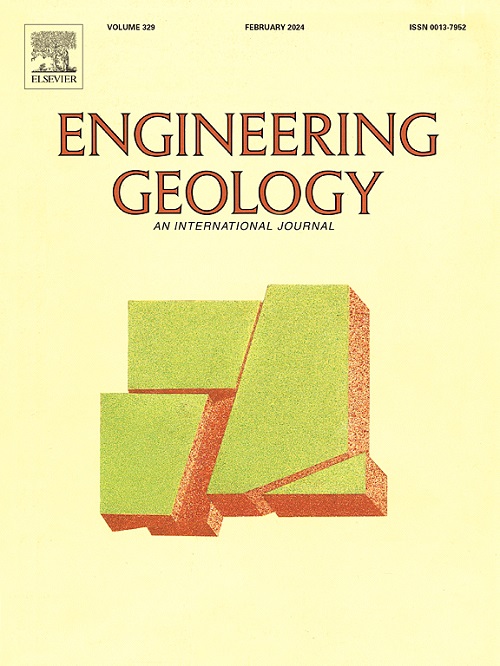Deep undrained failure mechanism of high-fill slopes on saturated grounds: centrifuge tests versus finite element limit analysis
IF 8.4
1区 工程技术
Q1 ENGINEERING, GEOLOGICAL
引用次数: 0
Abstract
The failure of high-fill slopes in the construction of airports, roads, and dam embankments may lead to significant human and economic losses. Rapid placement of fill with limited consolidation on saturated, low-permeability ground can trigger deep-seated landslides under undrained conditions. Prior studies on this deep undrained failure mechanism have primarily focused on low backfilled embankments. In cases with fill heights exceeding 20 m, it remains challenging to assess the stability of high-fill slopes on saturated grounds. To investigate the failure mechanism of the deep-seated landslides, a pair of centrifuge model tests based on the “modeling of models” method were conducted on a backfill slope over reconstituted saturated grounds. A similar failure mechanism of deep retrogressive flowslides was observed in both models. The landslides originated in the saturated ground beneath the slope face and foot, where increased gravity induced high excess pore water pressure, reducing the effective stress nearly to the level of static liquefaction. When these two plastic failure zones, located beneath the slope face and toe, merged into a deep flowslide surface, the deeply situated plastic failure caused the high backfills above to slide downward. Finite element limit analysis (FELA) and limit equilibrium method calculations, based on three undrained strength parameters obtained from soil mechanics laboratory and in situ miniature vane shear tests, were performed to validate the failure mechanism observed in the model tests. Finally, the failure assessment of a high-fill airport embankment was performed based on the validated FELA method. The results indicate a high risk of deep-seated undrained failure mechanisms in the original ground, with the depth of such failures closely related to the relative strength of the original ground compared with the backfills.
饱和地基上高填方边坡深层不排水破坏机制:离心试验与有限元极限分析
在机场、道路和堤坝建设中,高填方边坡的破坏可能导致重大的人员和经济损失。在饱和、低渗透性的地基上快速放置有限固结的填充物会在不排水的条件下引发深层滑坡。先前对这种深层不排水破坏机制的研究主要集中在低回填路堤上。在填土高度超过20 m的情况下,高填土边坡在饱和地基上的稳定性评估仍然具有挑战性。为探讨深部滑坡的破坏机理,采用“模型的建模”方法对某饱和地基上的回填边坡进行了两组离心模型试验。在两种模型中均观察到相似的深层退流式滑坡破坏机制。滑坡起源于坡面和坡脚下的饱和地层,重力的增加导致孔隙水压力过高,有效应力降低到接近静态液化的水平。当位于坡面和坡脚下方的这两个塑性破坏区合并为深部流滑面时,深部塑性破坏导致上部高充填体向下滑动。采用有限元极限分析(FELA)和极限平衡法计算,基于土力学实验室获得的三个不排水强度参数和原位微型叶片剪切试验,验证了模型试验中观察到的破坏机制。最后,基于验证的FELA方法对某高填土机场路堤进行了破坏评估。结果表明,原地表存在深部不排水破坏机制,破坏深度与原地表与充填体的相对强度密切相关。
本文章由计算机程序翻译,如有差异,请以英文原文为准。
求助全文
约1分钟内获得全文
求助全文
来源期刊

Engineering Geology
地学-地球科学综合
CiteScore
13.70
自引率
12.20%
发文量
327
审稿时长
5.6 months
期刊介绍:
Engineering Geology, an international interdisciplinary journal, serves as a bridge between earth sciences and engineering, focusing on geological and geotechnical engineering. It welcomes studies with relevance to engineering, environmental concerns, and safety, catering to engineering geologists with backgrounds in geology or civil/mining engineering. Topics include applied geomorphology, structural geology, geophysics, geochemistry, environmental geology, hydrogeology, land use planning, natural hazards, remote sensing, soil and rock mechanics, and applied geotechnical engineering. The journal provides a platform for research at the intersection of geology and engineering disciplines.
 求助内容:
求助内容: 应助结果提醒方式:
应助结果提醒方式:


